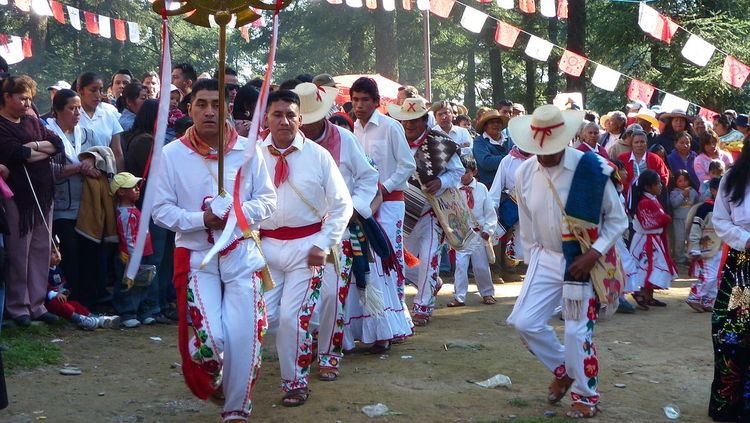 | ||
The Otomi people (/ˌoʊtəˈmiː/; Spanish: Otomí [otoˈmi]) are an indigenous ethnic group inhabiting the central altiplano (Mexican Plateau) region of Mexico.
Contents
Overview
The two most populous groups are the Highland or Sierra Otomí living in the mountains of La Huasteca and the Mezquital Otomí, living in the Mezquital Valley in the eastern part of the state of Hidalgo, and in the state of Querétaro. Sierra Otomí usually self-identify as Ñuhu or Ñuhmu depending on the dialect they speak, whereas Mezquital Otomi self-identify as Hñähñu (pronounced [ʰɲɑ̃ʰɲũ]). Smaller Otomi populations exist in the states of Puebla, Mexico, Tlaxcala, Michoacán and Guanajuato. The Otomi language belonging to the Oto-Pamean branch of the Oto-Manguean language family is spoken in many different varieties some of which are not mutually intelligible.
One of the early complex cultures of Mesoamerica, the Otomi were likely the original inhabitants of the central Mexican altiplano before the arrival of Nahuatl speakers around ca. 1000 CE, but gradually they were replaced and marginalized by Nahua peoples. In the early colonial New Spain period, Otomi speakers helped the Spanish conquistadors as mercenaries and allies, which allowed them to extend into territories that had previously been inhabited by semi-nomadic Chichimecs, for example Querétaro and Guanajuato.
The Otomi traditionally worshipped the moon as their highest deity, and even into modern times many Otomi populations practice shamanism and hold prehispanic beliefs such as Nagualism. Otomies traditionally subsisted on maize, beans and squash as most Mesoamerican sedentary peoples, but the Maguey (Century Plant) was also an important cultigen used for production of alcohol (pulque) and fiber (henequen).
Etymology
The name Otomi is an exonym and comes from the Nahuatl otomitl, which is possibly derived from an older word totomitl "shooter of birds". However, the Otomi refer to themselves as Hñähñú, Hñähño, Hñotho, Hñähü, Hñätho, Yųhų, Yųhmų, Ñųhų, Ñǫthǫ or Ñañhų, depending on which dialect of Otomi they speak. Most of the variant forms have two morphemes, meaning "speak" and "well" respectively.
The word Otomi entered Spanish through Nahuatl and is used to describe the larger Otomi macroethnic group and the dialect continuum. From Spanish, the word Otomi has become entrenched in linguistic and anthropological literature. Among linguists, the suggestion has been made to change the academic designation from Otomi to Hñähñú, the endonym used by the Otomi of the Mezquital valley, but no common endonym exists for all dialects of the language.
Language
Otomi is one of the Oto-Pamean languages family, which also includes Chichimeca Jonaz, Mazahua, Pame, Ocuilteco, and Matlatzinca, which belong to the Otomangean language group (Amuzgoan, Chinantecan, Mixtecan, Otopamean, Popolocan, Tlapanecan, and Zapotec language families).
